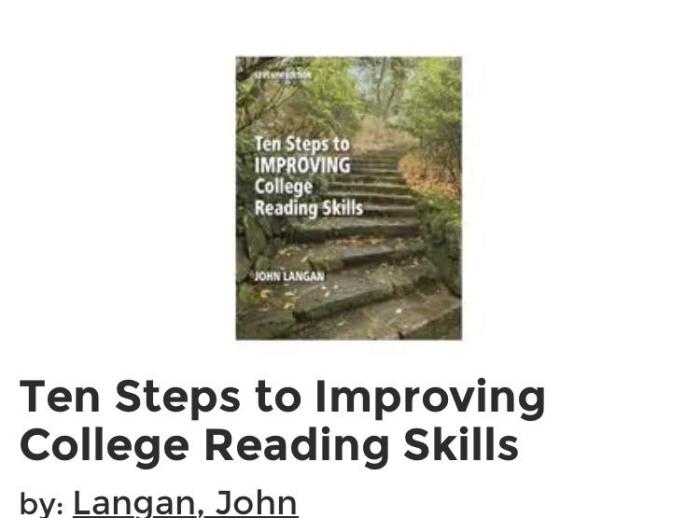Ten steps to mastering college reading skills sets the stage for this enthralling narrative, offering readers a glimpse into a story that is rich in detail and brimming with originality from the outset. This guide delves into the intricacies of effective reading strategies, empowering students with the tools they need to excel in their academic pursuits and beyond.
Throughout this comprehensive exploration, readers will embark on a journey of discovery, uncovering the secrets to unlocking the full potential of their reading abilities. With each step, they will gain invaluable insights into the art of previewing texts, activating prior knowledge, setting purposeful reading goals, and engaging in active reading techniques.
Step 1: Previewing the Text

Previewing a text before reading can significantly enhance comprehension. By examining the text’s structure, headings, subheadings, and any visual aids, readers can gain a general understanding of the content and its organization. Previewing also helps identify key concepts and vocabulary, which can facilitate comprehension and retention.
Step 2: Activating Prior Knowledge
Activating prior knowledge involves connecting new information to existing knowledge and experiences. By reflecting on what they already know about the topic, readers can create a framework for understanding the new material. This process helps make the text more meaningful and relatable, enhancing comprehension and retention.
Step 3: Setting a Purpose for Reading
Establishing a purpose for reading provides direction and focus. Before beginning to read, readers should consider their reasons for engaging with the text. Whether it’s to gain general knowledge, answer specific questions, or critically evaluate the content, setting a clear purpose helps readers identify relevant information and improve comprehension.
Step 4: Reading Actively
Active reading involves engaging with the text on a deeper level. Techniques such as highlighting, annotating, and summarizing help readers focus their attention, process information, and make connections. By actively engaging with the text, readers can improve their comprehension and retention.
Step 5: Monitoring Comprehension
Monitoring comprehension is crucial for ensuring understanding. While reading, readers should regularly pause to assess their comprehension. By identifying areas of confusion or uncertainty, readers can take steps to clarify their understanding, such as rereading, consulting additional resources, or seeking help from others.
Step 6: Inferring and Interpreting
Inferring involves drawing conclusions based on the information provided in the text. By identifying implied meanings and connections, readers can deepen their understanding of the material. Interpreting, on the other hand, involves forming personal interpretations of the text based on their own experiences and perspectives.
Both inferring and interpreting contribute to a richer and more nuanced comprehension of the text.
Step 7: Evaluating the Text
Evaluating the text involves assessing its credibility, reliability, and relevance. By considering the author’s qualifications, the evidence presented, and the overall coherence of the text, readers can determine the trustworthiness and validity of the information. This critical evaluation helps readers make informed judgments about the text and its content.
Step 8: Applying the Information
Applying the information learned from reading is essential for effective learning. By connecting the new knowledge to real-world situations, readers can enhance their understanding and retention. This application can take various forms, such as using the information to solve problems, make decisions, or engage in critical discussions.
Step 9: Reviewing and Revisiting
Regularly reviewing and revisiting texts strengthens comprehension and retention. By spacing out review sessions, readers can reinforce their understanding and identify areas that need further attention. Revisiting the text also allows readers to make connections between different sections and gain a deeper appreciation for the content.
Step 10: Seeking Help
When encountering difficulties with reading, it’s important to seek help. Students may consider reaching out to instructors, tutors, or classmates for clarification, support, and guidance. Utilizing available resources can help overcome obstacles, improve comprehension, and foster a positive learning environment.
Helpful Answers: Ten Steps To Mastering College Reading Skills
What are the key benefits of effective reading strategies?
Effective reading strategies enhance comprehension, improve critical thinking skills, increase retention, boost academic performance, and foster a lifelong love of learning.
Why is it important to set a purpose for reading?
Setting a purpose for reading provides direction and focus, guiding readers towards specific goals, improving comprehension, and maximizing learning outcomes.
What is the difference between inferring and interpreting?
Inferring involves drawing conclusions based on evidence within the text, while interpreting involves forming judgments and making connections to personal experiences and knowledge.

